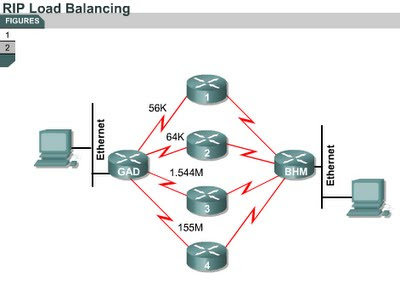Integrating static routes with RIP
7.2.10 This page will explain how static routes can be configured on a router that uses RIP.
Static routes are user-defined routes that force packets to take a set path from a source to a destination. Static routes become very important if the Cisco IOS software does not learn a route to a particular destination. They are also used to specify a gateway of last resort, which is commonly referred to as a default route. If a packet is destined for a subnet that is not explicitly listed in the routing table, the packet is forwarded to the default route.
A router that runs RIP can receive a default route through an update from another router that runs RIP. Another option is for the router to generate the default route itself.
Use the no ip route global configuration command to remove static routes. The administrator can override a static route with dynamic routing information by adjusting the administrative distance values. Each dynamic routing protocol has a default administrative distance (AD). A static route can be defined as less desirable than a dynamically learned route, as long as the AD of the static route is higher than that of the dynamic route. Note that after the static route to network 172.16.0.0 through 192.168.14.2 was entered, the routing table does not show it. Only the dynamic route learned through RIP is present. This is because the AD of 130 is higher for the static route, and unless the RIP route through S0/0 goes down, the static route will not be installed in the routing table.
Static routes that point out an interface will be advertised by the RIP router that owns the static route and propagated throughout the internetwork. This is because static routes that point to an interface are considered in the routing table to be connected and thus lose their static nature in the update. If a static route is assigned to an interface that is not defined in a network command, a redistribute static command must be specified in the RIP process before RIP will advertise the route.
When an interface goes down, all static routes pointing out that interface are removed from the IP routing table. Likewise, when the software can no longer find a valid next hop for the address specified in the static route, then the static route is removed from the IP routing table.
In Figure a static route has been configured on the GAD router to take the place of the RIP route in the event that the RIP routing process fails. This is referred to as a floating static route. To configure the floating static route, an AD of 130 was defined on the static route. This is greater than the default AD of RIP, which is 120. The BHM router would also need to be configured with a default route.
The Lab Activity will teach students how to define static routes when RIP is used.
This page concludes this lesson. The next lesson will discuss IGRP. The first page provides an overview of IGRP.




